Oden News Flash!Before we get to today's topic I need to make a few announcements....Penguins!!! This morning while I was on the bridge, I looked out and saw 2 black and white birds floating on the surface about 100 meters in front of the ship. As we approached them I grabbed the binoculars and I could clearly watch my first wild penguins. Magellanic penguins nest on the Southern tip of South America and spend much of the year out at sea where they dive for fish. From 100 feet above them there was no way for me to take a picture so I have "borrowed" one from a field guide.
Check out the Swedish teacher's blog. Marja Andersson is the Swedish teacher aboard the Oden and she has a blog too. She works for the Swedish Royal Academy of Science and she instructs teachers all over Sweden how to use inquiry based science teaching techniques. You can link to her blog at http://antarktis2008-09.spaces.live.com Of course, it is in Swedish but if you copy the text into Google translator it comes out in fairly clear English. Give it a try! (this is an assignment for my students)
Time Delay?? Because the Oden does not have any internet service and we only receive email a few times each day through our satellite phone connection, you should expect at least a 1-2 day delay in my responses to Ask The Team questions. It also takes me 3-4 hours each day to create and send each journal post. The journal post you see before you was sent as 9 emails to the ARCUS folks in Alaska. Then the ARCUS Webmaster Ronnie reconstructed my emails into this journal posting. Thanks Ronnie!
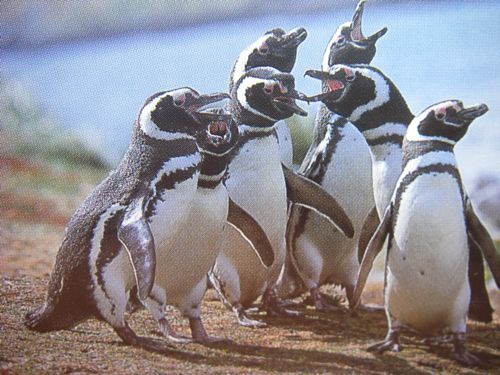
Now, for our journey into the belly of the beast! Mr. Calderwood's class asked questions a few days ago about where the drinking water on the Oden came from and what happens to wastewater on the ship. You can imagine that the 54 people on board use quite a bit of water for cooking, cleaning, laundry, showers, sinks, toilets and of course, drinking. I asked the ship's 1st Officer Thomas to help me and he arranged for a complete tour of the engineering department below decks. At 1pm I met 1st Engineer Marcus Hillberg and took the other teacher, Marja Andersson and I down a few flights of steep metal stairs below the Oden's deck. As if we had climbed down into the belly of a whale, everywhere below deck is very warm, is very noisy and smells of oil. Everyone must wear ear protection and it is often hard to hear what is being said over the roar of engines, pumps, fans, etc.
Fresh Water
Most people in the United States get fresh water that is supplied by pipes from a town or city water supply. In turn, that water starts out in lakes, rivers or underground wells and is filtered, chlorinated to kill bacteria and is safe to drink. Like a small town, the Oden makes its own freshwater.....but the source is the sea. And, I must say it tastes just fine. The osmotic membrane system shown in the photo below produces 12-14 cubic meters of drinking water/day and it is stored in two 149 cubic meter tanks. There is also a second freshwater system on the Oden that produces water for the engine and steam heat system. Instead of osmotic membranes, it uses distillation to get the salt out of the seawater. The ocean water is pumped into a tank and then the air is pumped out to create a vacuum. Without air pressure, the seawater boils at 47˚C instead of a normal 102˚C. Heat from the engine coolant is added to the seawater tank and it makes the seawater boil. The steam is then condensed to create pure H2O. This system can produce 14-17 cubic meters of freshwater/day.
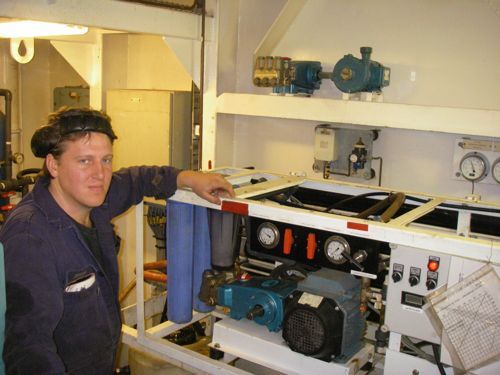
Wastewater
Back home most people don't think much about what happens to water after it goes down the drain. However, it generally goes into a municipal sewage treatment plant where bacteria and chemistry are used to breakdown and separate the organic wastes and solids from the rest of the water so that the somewhat cleaner water can be discharged into a lake or river. At my house in the country, all of our wastewater goes into a 1200-gallon concrete septic tank buried in my yard and the outflow water soaks into the soil so that the microorganisms in the soil can finish the job of cleaning the wastewater. Here on the Oden, wastewater gets much the same treatment. It is collected, stirred into a consistent liquid and then bacteria and chemistry takes over to break down the organic stuff. The final "gray-water" is pumped back into the sea where it adds nutrients to the marine food web.
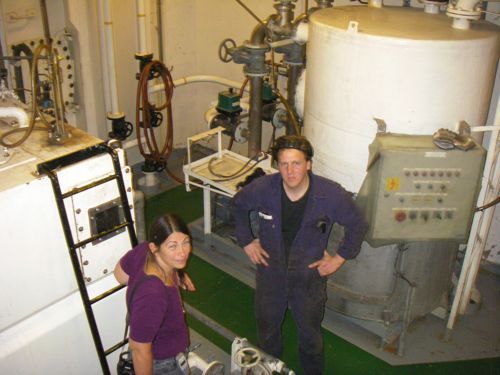
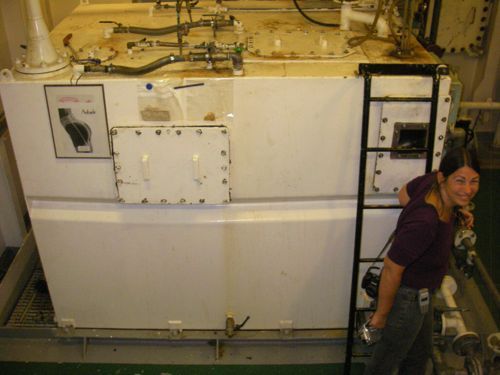
Garbage??
Everyone on the Oden is expected to help sort the trash into bins labeled for "metal", "plastic" and "paper". There is also a bin in the galley for food scraps. All of the metal, plastic and paper is separated and compacted for storage aboard the ship. This trash will be moved off the ship when it returns to Montevideo in 4 months and again when the Oden returns to Sweden in April. The food wastes are ground up and discharged into the sea where they are rapidly consumed by the hungry members of the marine ecosystem.
Engines and Pumps
The Oden is propelled by 2 gigantic propellers that are each attached to 2 oil-burning engines that are about the size of a school bus! They are so large that I could not get them to fit onto a single photo! Most of the time, only 2 of the engines are used to drive the ship forward at 10-15 mph. When the seas are rough or we are cutting through ice the crew will switch to 3-4 engines. There are also 5 auxiliary engines that are each the size of a mini-van used to produce the electricity for the ship and to drive the many water pumps. Speaking of water pumps check out the monster below.
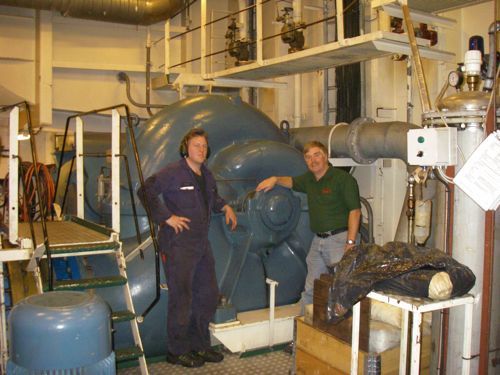
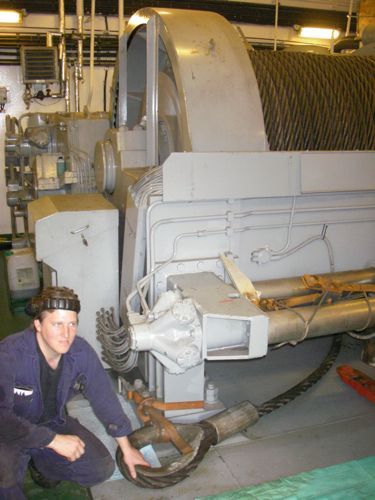
Flags of the Day!
Today I received the last flag created by a classroom. Everyone on the Oden is so interested in and excited about the flags that I have been asked to display them for all to enjoy. Today I hung all 139 flags in a continuous string that wound 1.5 times around the mess room. The flags will stay up for at least a few days and at each meal we are surrounded by a reminder that although we are isolated, hundreds of miles from land, we are not alone. Thousands of children and adults are with us. [To see a photo of all the flags Jeff received, visit the Photo Gallery.]
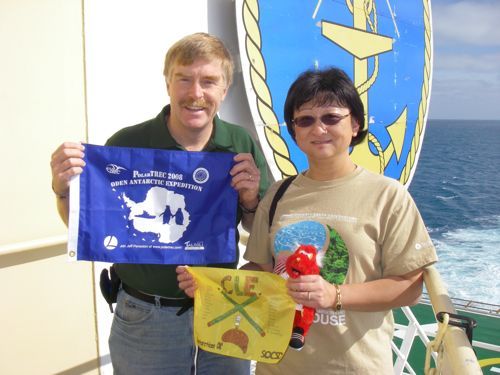
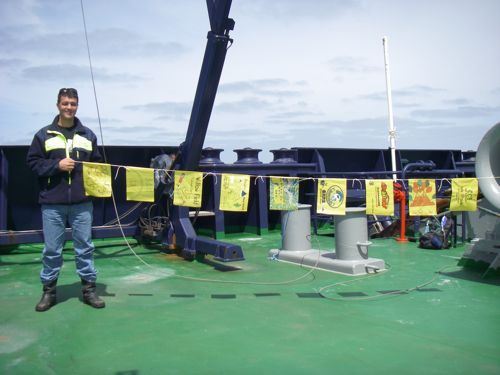
Today's flags include: Camp Good Days and Special Times, Mendon, NY Ms. Worssam's class, New Start Middle School, Flagstaff, Arizona Copenhagen Music Dept. Copenhagen, NY Mrs. Baker's 7th Gr, Onondaga Hill Middle School, Syracuse, NY Star Lake Camp, The Salvation Army, Bloomingdale, NJ The Luber-Mercer-Maxwell 4th Gr, Solvay Middle School, Solvay, NY Ms. Larson & Ms. Dischinger's 3rd Gr, Soule Road Elem, Liverpool, NY Willow Field Elementary, Liverpool, NY
Take care, have fun & make memories,
Jeff Peneston


Comments